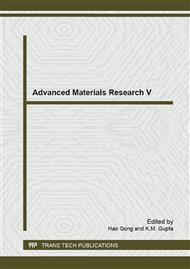[1]
S.M. Tadayyon, H.M. Grandin, K. Griffiths, P.R. Norton, H. Aziz and Z.D. Popovic, CuPc buffer layer role in OLED performance: a study of the interfacial band energies, Org Electron. 5 (2004) 157-166.
DOI: 10.1016/j.orgel.2003.10.001
Google Scholar
[2]
F. Yang, M. Shtein and S.R. Forrest, Controlled growth of a molecular bulk heterojunction photovoltaic cell, Nature Materials. 4 (2004) 37-41.
DOI: 10.1038/nmat1285
Google Scholar
[3]
C. Kodituwakku, C. Burns, A. Said, H. Sinn, X. Wang, T. Gog, D. Casa and M. Tuel, Resonant inelastic x-ray scattering studies of the organic semiconductor copper phthalocyanine, Physical Review B. 77 (2008).
DOI: 10.1103/physrevb.77.125205
Google Scholar
[4]
Y. Sadaoka, T.A. Jones, G.S. Revell and W. Göpel, Effects of morphology on NO2 detection in air at room temperature with phthalocyanine thin films, Journal of Materials Science. 25 (1990) 5257-5268.
DOI: 10.1007/bf00580159
Google Scholar
[5]
Z. Bao, A.J. Lovinger and A. Dodabalapur, Organic field-effect transistors with high mobility based on copper phthalocyanine, Appl Phys Lett. 69 (1996) 3066.
DOI: 10.1063/1.116841
Google Scholar
[6]
H. Wang, S. Mauthoor, S. Din, J.A. Gardener, R. Chang, M. Warner, G. Aeppli, D.W. McComb, M.P. Ryan, W. Wu, A.J. Fisher, M. Stoneham and S. Heutz, Ultralong copper phthalocyanine nanowires with new crystal structure and broad optical absorption, ACS Nano. 4 (2010).
DOI: 10.1021/nn100782w
Google Scholar
[7]
K. Xiao, Y. Liu, G. Yu and D. Zhu, Influence of the substrate temperature during deposition on film characteristics of copper phthalocyanine and field-effect transistor properties, Applied Physics A: Materials Science & Processing. 77 (2003).
DOI: 10.1007/s00339-003-2169-6
Google Scholar
[8]
Y. -L. Lee, W. -C. Tsai and J. -R. Maa, Effects of substrate temperature on the film characteristics and gas-sensing properties of copper phthalocyanine films, Appl Surf Sci. 173 (2001) 352-361.
DOI: 10.1016/s0169-4332(01)00019-8
Google Scholar
[9]
M. Komiyama, Y. Sakakibara and H. Hirai, Preparation of highly ordered ultrathin films of copper(II) phthalocyanine on amorphous substrates by molecular beam deposition, Thin Solid Films. 151 (1987) L109-L110.
DOI: 10.1016/0040-6090(87)90016-2
Google Scholar
[10]
S. Ambily, F.P. Xavier and C.S. Menon, Photoconductivity measurements in lead phthalocyanine thin films, Mater Lett. 41 (1999) 5-8.
DOI: 10.1016/s0167-577x(99)00094-4
Google Scholar
[11]
E.A. Lucia and F.D. Verderame, Spectra of Polycrystalline Phthalocyanines in the Visible Region, The Journal of Chemical Physics. 48 (1968) 2674-2681.
DOI: 10.1063/1.1669501
Google Scholar
[12]
L. Edwards and M. Gouterman, Porphyrins: XV. Vapor absorption spectra and stability: Phthalocyanines, I Mol Spectrosc. 33 (1970) 292-310.
Google Scholar
[13]
A. Ritz and H. Luth, The electronic structure of GaP (110) and Cu-Phthalocyanine overlayers studied by ellipsometry, Applied Physics A Solids and Surfaces. 31 (1983) 75-80.
DOI: 10.1007/bf00616308
Google Scholar
[14]
B.H. Schechtman and W.E. Spicer, Near infrared to vacuum ultraviolet absorption spectra and the optical constants of phthalocyanine and porphyrin films, I Mol Spectrosc. 33 (1970) 28-48.
DOI: 10.1016/0022-2852(70)90050-0
Google Scholar


